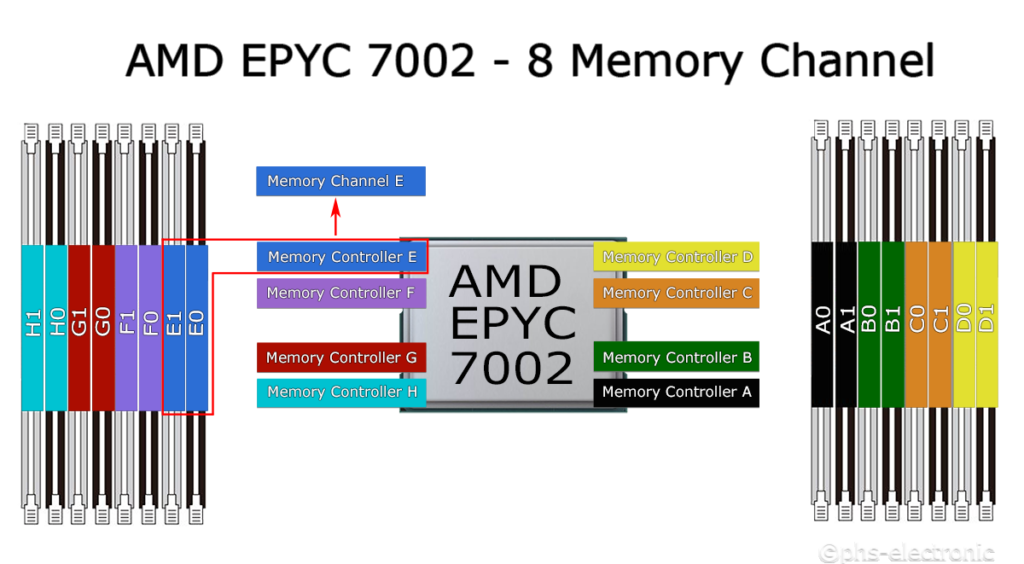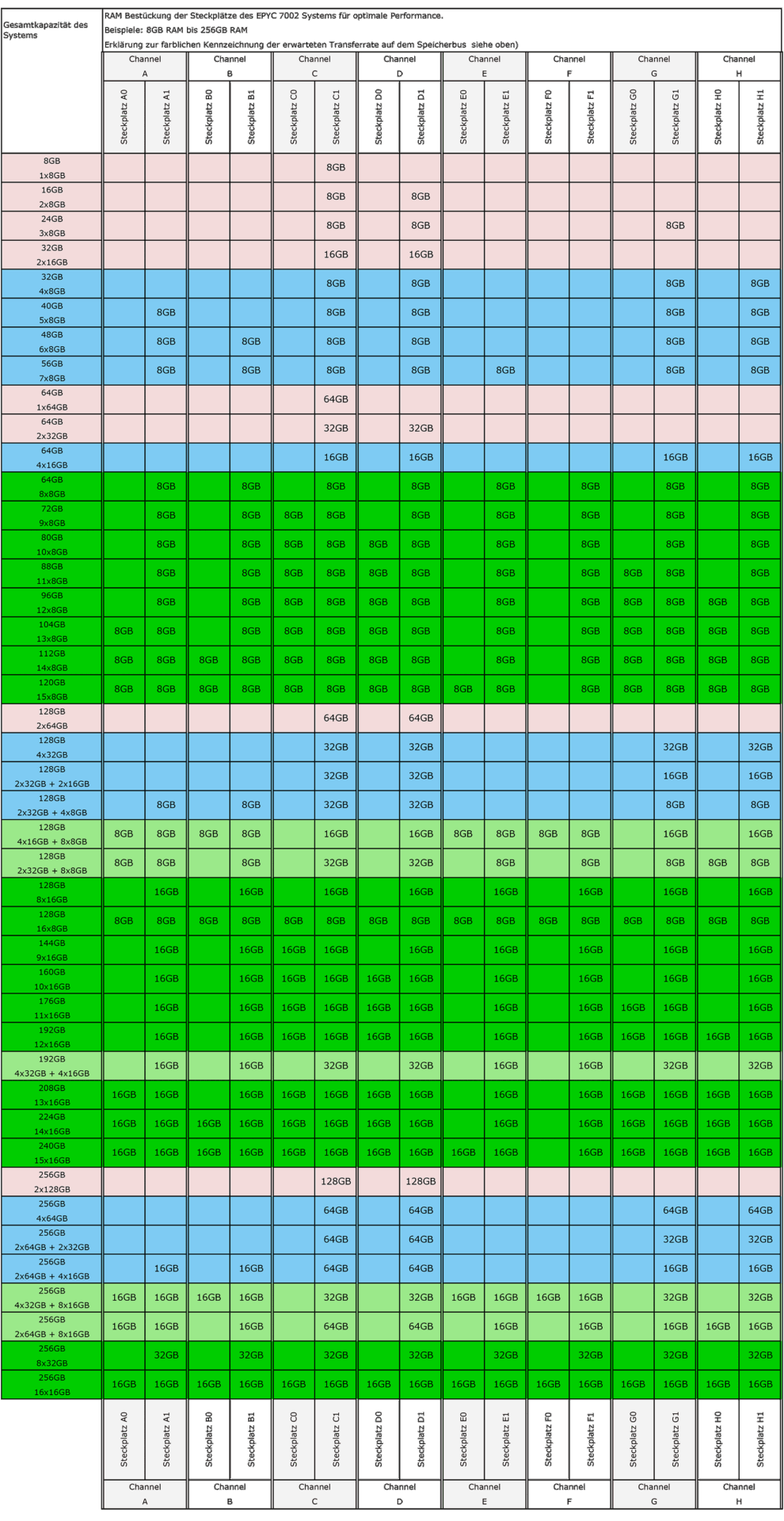
Each memory channel can be equipped with one or two DIMM slots. This allows an EPYC 7002 CPU to directly address up to 16 memory modules.
The way memory is arranged on the motherboard has a significant impact on the system’s overall performance.
We have divided the four possible “performance levels” of the resulting transfer rate on the memory bus (between RAM and CPU) as follows, color-coded and marked accordingly in the RAM configuration table.
| Best Performance (100%) | Each Memory Channel is populated with 1 or 2 memory modules of identical capacity and speed |
| Good Performance (95%) | Each Memory Channel is populated with 1 or 2 memory modules with pairwise identical modules, but not all modules have the same capacity |
| Moderate Performance (50-55%) | Half of the Memory Channels are populated with 1 memory module. Whether identical or different capacities makes little difference |
| Poor Performance (25%) | Only 1 or 2 slots are used, most DIMM slots are empty |
Examples of RAM configurations for an EPYC 7002-based system:
Using a motherboard with 16 DIMM slots and an EPYC 7002 CPU as an example, we have outlined the various RAM configuration options up to 256GB. Contact us if you have any questions about configuring your motherboard’s memory.
Number of slots on the board: 16
Number of CPU sockets on the board: 1

Our recommendation: Equip each memory channel
- It is ideal to pair each memory channel, but as long as each channel has at least one memory module, a near-balanced configuration will provide good performance.
- It’s advantageous to equip empty channels before filling a second slot in an already occupied channel.
- AMD recommends populating all 8 channels.
| Example: | |
| 8 x 16GB: | ideal configuration, 100% memory bus transfer rate |
| 4 x 8GB + 4 x 32GB: | nearly ideal configuration, 95% memory bus transfer rate |
Not recommended: populating only single memory channels
- 4 DIMMs with 8 channels: approx. 50-55% memory bus transfer rate
- 2 DIMMs with 8 channels: approx. 25-30% memory bus transfer rate
Example: Transfer rate for identical RAM capacity with varying DIMM numbers on an AMD EPYC 7002 motherboard with 16 slots and one CPU.

The following combinations are not possible:
- Mixing memory technologies such as RDIMM, LRDIMM, or 3DS DIMM on the CPU’s memory slots is not possible.
- Within a channel with two DIMM slots, x4 and x8-based memory and 8Gbit and 16Gbit-based memory cannot be mixed. Memory must be technically identical to the existing memory.
| Example: | |
| Slot A0: 16GB 2Rx8 and Slot A1: 16GB 1Rx8 |
not possible |
| Slot A0: 16GB 2Rx8 and Slot A1: 16GB 2Rx4 |
not possible |
Contact us if you’re unsure which memory to add to your existing memory.
Possible combinations:
- With a motherboard containing two EPYC 7002 CPUs, each CPU can be configured differently with RDIMM, LRDIMM and 3DS DIMM modules.
- For each CPU, see “The following combinations are not possible”.
- Within a CPU, x4 and x8-based memory and 8Gbit and 16Gbit-based memory can be mixed in each memory channel.
| Example: | |
| Slot A0: 16GB 2Rx8 and Slot B0: 16GB 1Rx8 |
is possible |
| Slot A0: 16GB 2Rx8 and Slot B0: 16GB 2Rx4 |
is possible |
Contact us if you’re unsure which memory to add to your existing memory.
RAM Interleaving for EPYC 7002:
- To enable interleaving, memory modules with identical capacities and ranks must be used.
- Two-way interleaving: each first DIMM slot of, for example, memory channels C+D is populated with identical RAM modules.
- Four-way interleaving: each first DIMM slot of, for example, memory channels A+B and C+D is populated with identical RAM modules.
- Eight-way interleaving: each first DIMM slot of, for example, memory channels A+B+C+D+E+F+G+H is populated with identical RAM modules.
RAM Interleaving: In RAM interleaving, data blocks are divided across multiple memory modules during transfer between CPU and RAM, allowing each module more time to process data and improving overall system performance.
Conclusion:
If you do not populate each memory channel:
- you may have lower immediate costs
- many free slots allow for potential upgrades later
- power consumption will be slightly reduced.
If you populate each memory channel immediately:
- you will achieve the highest possible memory bus transfer rate right away
- the entire system can be fully utilized immediately.
